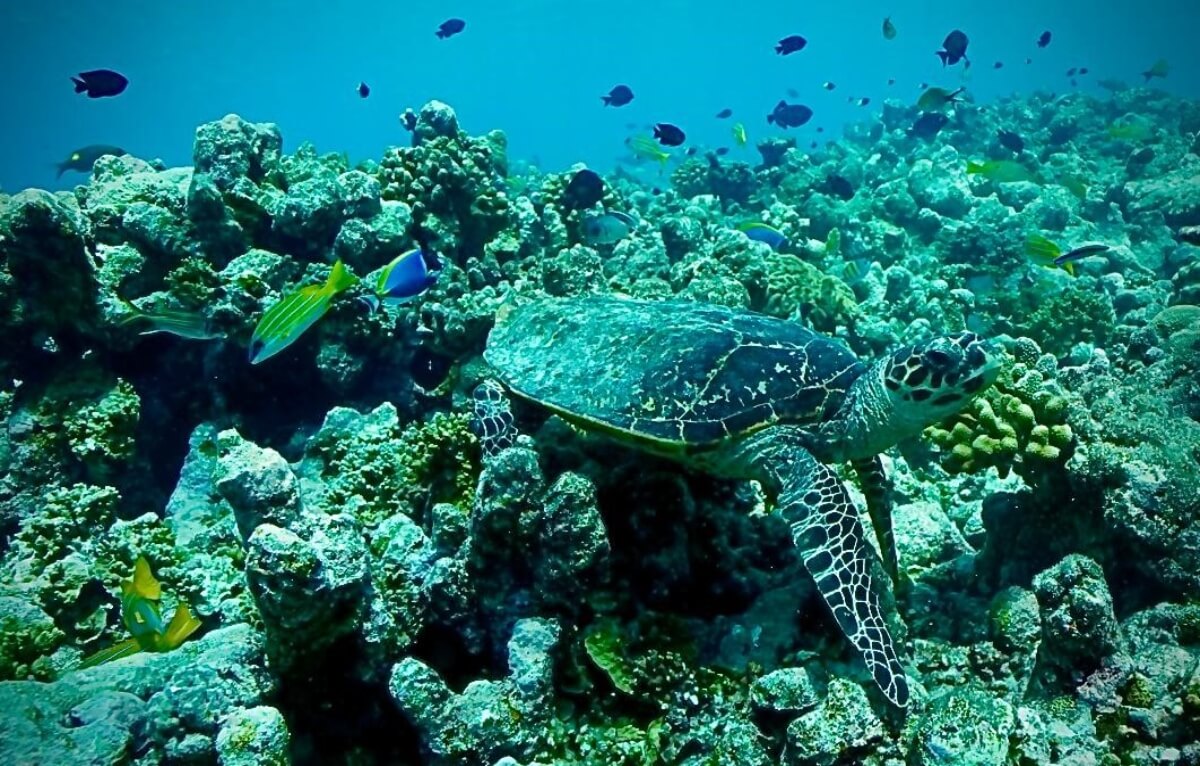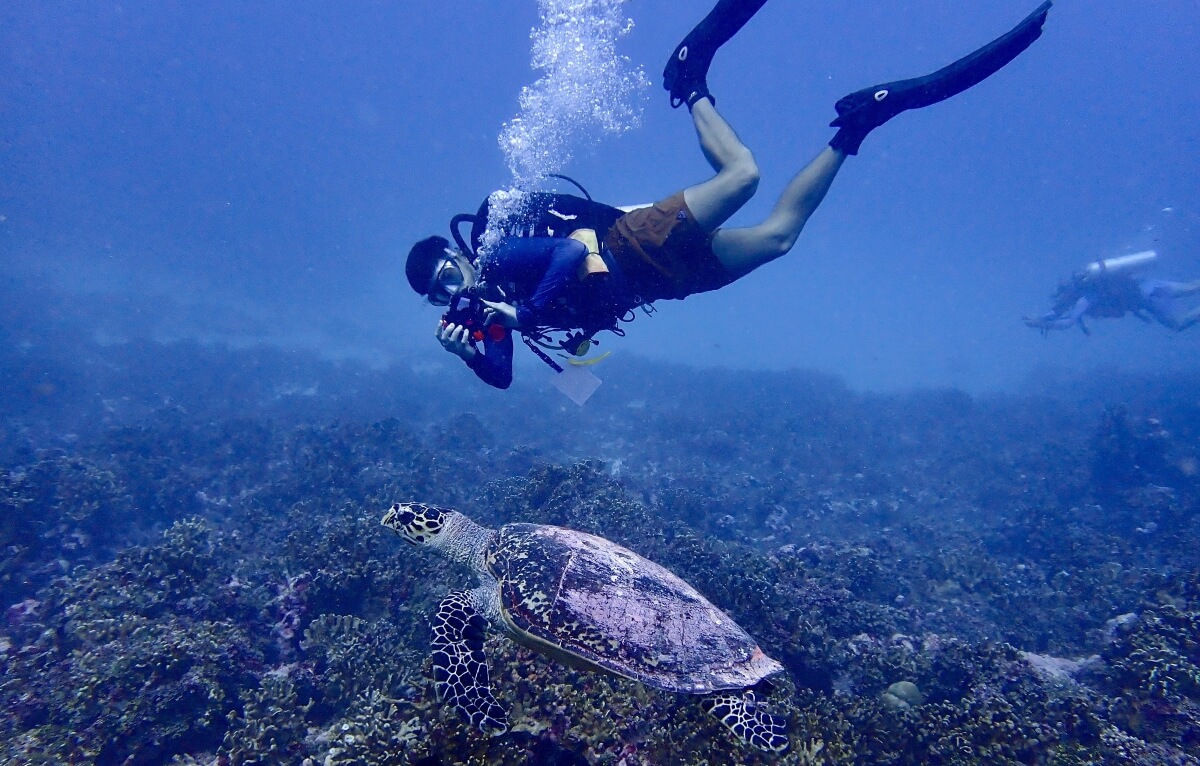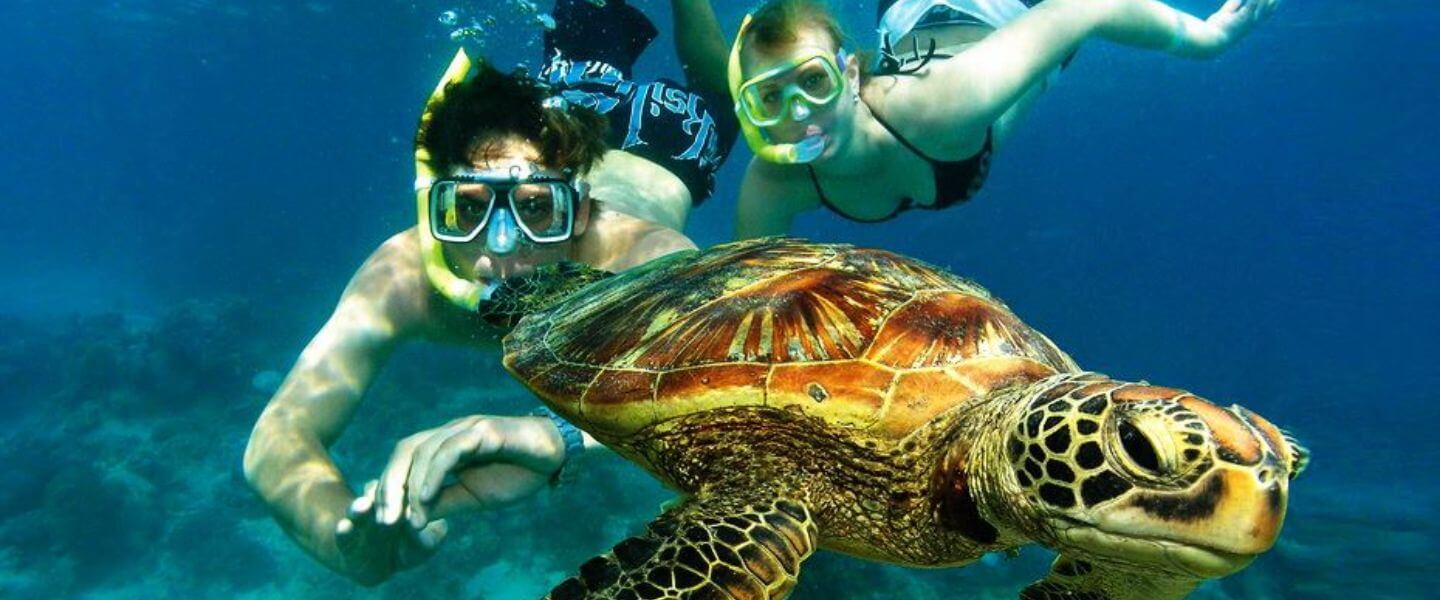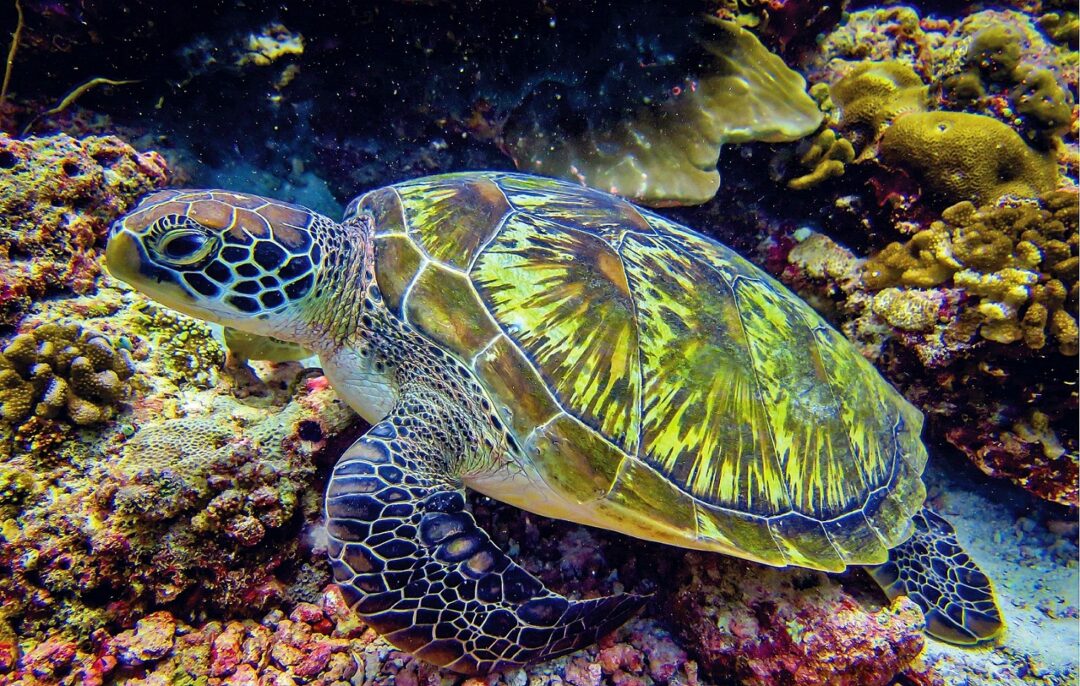HOW TO HAVE A RESPONSIBLE TURTLE ENCOUNTER IN THE MALDIVES

A trip to the Maldives is not complete without exploring the beauty that lies beneath the surface of our aqua marine water. It is a coral oasis where the underwater realm pulses with a symphony of life – fish, corals, crustaceans, and a myriad of critters, all partaking in a delicate and dazzling dance, ready to be witnessed by you. Amidst this aquatic spectacle, there’s one encounter that you absolutely cannot afford to miss – the majestic sea turtles. These incredible marine marvels grace the pristine turquoise waters of the Maldives, offering a once-in-a-lifetime experience that will leave you awestruck.
As you prepare to plunge into this underwater realm it’s important to keep in mind the significance of treating both the ocean and its marine life with the utmost respect. Your responsible behavior will not only ensure a longer and richer turtle encounter but it will also safeguard the environment upon which they depend.

Code of Conduct for Snorkelers and Divers
Encountering a sea turtle while snorkeling or diving in the Maldives is a truly magical experience. To ensure a mindful and beneficial encounter for both you and the turtles, follow these simple guidelines provided by the Olive Ridley Project:
- Be quiet: Approach turtles quietly, minimising splashing and talking.
- Do not disrupt their natural behaviour: Watch and enjoy without interfering.
- Approach from the side: Give turtles a clear view of you and a path to swim away if they choose.
- Do not chase or touch turtles: Chasing or touching turtles can cause them severe stress.
- Do not swim directly above turtles: They need to come to the surface to breathe.
- Maintain a safe distance, ideally 1.5m: Turtles can deliver a strong bite if they feel threatened.
- Do not feed turtles: They can find their own food and may accidentally bite you.
- Pay attention: Observe turtles closely and avoid disturbing resting turtles.
- Be still: If a turtle swims towards you, keep still and avoid sudden movements.
- Give them space : Allow turtles resting in caves or under overhangs to surface and breathe freely.
Remember to follow any additional regulations provided by your snorkeling or dive guide which may be specific to the turtle sites you visit. By respecting these guidelines, you can ensure the well-being of these incredible creatures as well as contributing to turtle conservation.

Types of Turtles in the Maldives
In the Maldives, you’ll come across various turtle species, each with its own unique charm. Let’s dive into some fascinating details about these remarkable creatures.
Hawksbill Turtles:
Hawksbill Turtles are a common sight in the Maldives, but despite being the most commonly sighted turtle, they are critically endangered and the majority of the population are juveniles. It is also rare to find them nesting. These graceful creatures can be found in different parts of the Maldives, especially around coral reefs and feeding areas. With their beautiful shells and
beak-like mouths, Hawksbill Turtles are truly captivating and they play a significant role in maintaining the health of coral reefs. Remember to respect their habitat and observe them from a distance, allowing them to thrive undisturbed.
- Sighting frequency: High
- Conservation Status: Critically Endangered globally and nationally
Green Sea Turtles:
Spotting a Green Sea Turtle is like discovering hidden treasure in the Maldives and they are often found near seagrass beds. These gentle creatures, with their smooth, olive-coloured shells, capture the hearts of all who encounter them. Even though their population in the Maldives is less than hawksbills, there are more records of nesting and most green sea turtles encountered will be adults. Understanding their behaviour and characteristics helps us appreciate their vital role in the marine ecosystem.
- Sighting frequency: Moderate
- Conservation Status: Endangered globally and nationally
Olive Ridley Turtles:
Olive Ridley Sea Turtles, named after their olive-coloured shells, occasionally grace the Maldivian waters. These turtles are known for their synchronised nesting behaviour, where hundreds of them gather to lay eggs on sandy beaches. Learning about Olive Ridley Sea Turtles allows us to appreciate their incredible journey from the west side of the globe to the east and the challenges they face.
- Sighting frequency: Low
- Conservation Status: Endangered globally
Leatherback Sea Turtles:
Leatherback Sea Turtles, the largest of all sea turtle species, occasionally visit the Maldivian waters. These magnificent creatures can be found in the open ocean and have a unique, leathery shell instead of a hard one. Understanding their behaviours and characteristics enables us to protect their fragile population and ensure their continued existence.
- Sighting frequency: Rare
- Conservation Status: Endangered globally
Loggerhead Sea Turtles:
Loggerhead Sea Turtles are occasionally spotted in the Maldives, known for their large heads and powerful jaws. These charismatic creatures prefer coastal areas and play an important role in maintaining the balance of the marine ecosystem. Learning about Loggerhead Sea Turtles allows us to contribute to their conservation efforts.
- Sighting frequency: Rare
- Conservation Status: Endangered globally

Common Threats Sea Turtles in the Maldives Face
As conscious travelers, it’s important to be aware of the challenges sea turtles face in the Maldives. Several turtle species are classified as endangered under Maldivian law due to various threats. These include accidental capture in ghost nets, (fishing nets and line that are drifting in the ocean) as well as climate change which has an impact on turtle nesting sites; it alters sand temperatures, which then affects the sex of hatchlings. Coastal development, the ingestion of plastic and marine debris, illegal take and the harvesting of sea turtle eggs all impact the overall global turtle population.
The Olive Ridley Project, a dedicated organisation focused on the conservation and protection of sea turtles and their habitats in the Maldives, stands as a beacon of hope. With a mission to reduce the threats faced by sea turtles in the region, they work tirelessly to rescue, rehabilitate, and release injured turtles, as well as conduct vital research and conservation initiatives.
The organisation places significant emphasis on educating local communities, tourists, and stakeholders about the importance of sea turtle conservation. They aim to foster a sense of responsibility and encourage sustainable practices to ensure the long-term survival of these magnificent creatures.

Join us on our 7 night Turtle Conservation Cruise. Embark on a cruise of discovery and make a positive impact on the marine life of the Maldives through our unique cruise itinerary focused on citizen science and turtles. This unique itinerary is for everyone with a passion for turtles, the ocean and responsible travel.
We have joined forces with The Olive Ridley Project (ORP) who are on a mission to protect sea turtles and their habitats, through rescue and rehabilitation, scientific research, and education. As you cruise the waters of South Male and Vaavu Atoll on board MV Felicity, you’ll not only enjoy the breathtaking beauty of the Maldives but also actively contribute to the conservation of these incredible creatures.
Click here to find out more or to book your spot!